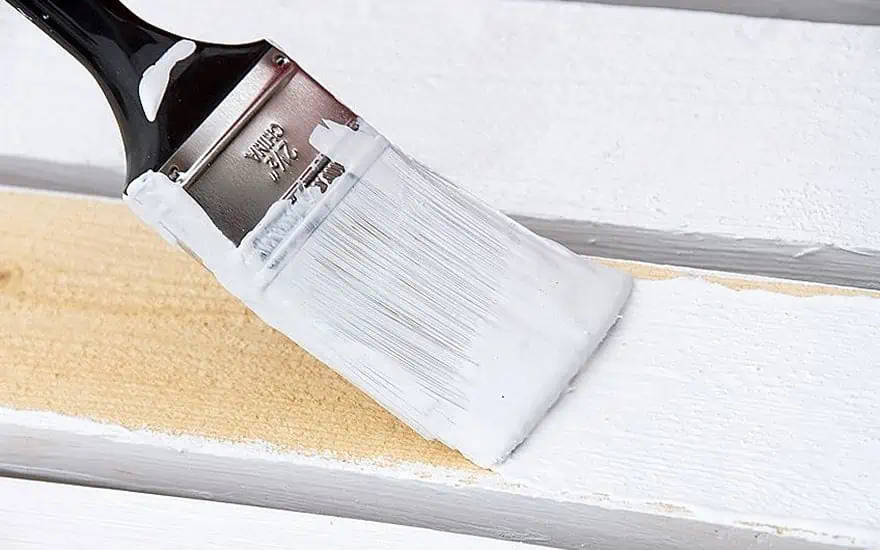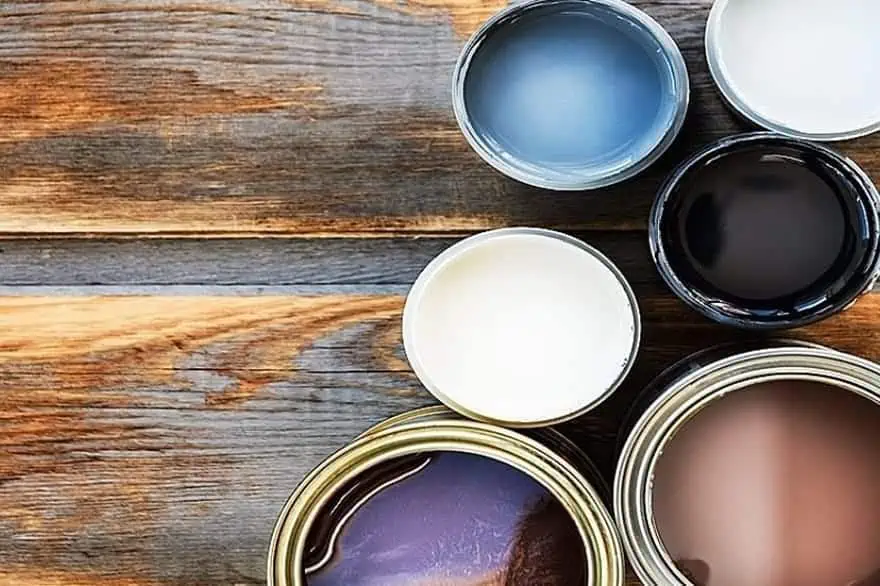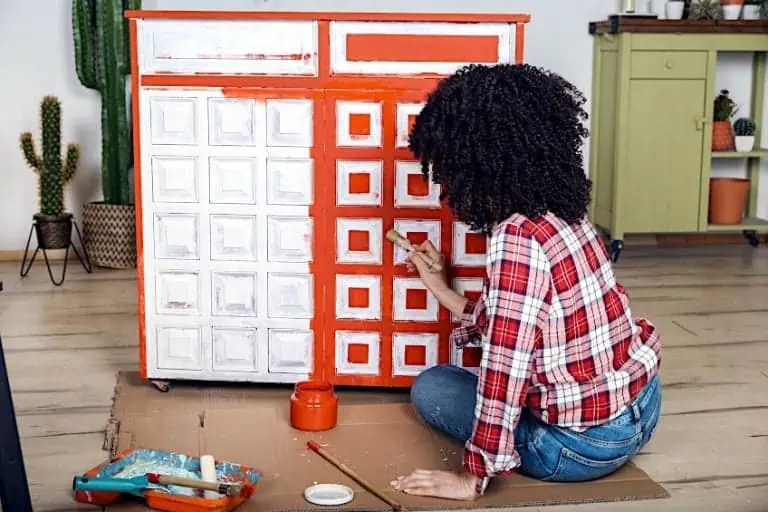Acrylic Paint on Wood – Does Acrylic Paint Work on Wood?
This post may contain affiliate links. We may earn a small commission from purchases made through them, at no additional cost to you.
You will be forgiven for thinking that acrylic paints are exclusive to canvas art. However, the reality is that acrylic paint can be used on a multitude of surfaces, this includes paper, metal, leather, fabric, and so on. Due to acrylic paint being able to adhere to any non-glossy surface, wood is a perfect candidate for a fresh coat, and not only is it a cost-effective option, but it is also easy to apply.
Table of Contents
Does Acrylic Paint Work on Wood?
Acrylic paint is a quick-drying and non-toxic product due to it being a water-based formula that consists of pigments that have been spread by means of an acrylic polymer emulsion. This paint is also easy to clean, and all it takes is some soapy water. A wide range of woods can easily be given a fresh coat of acrylic paint, provided that you follow the necessary steps that will result in the enhanced durability of your project. This is why acrylic paint has become an incredibly popular choice for a variety of wood crafts. This is because they are readily available at most stores, so there is no need to head to a special arts and crafts outlet. The non-toxic formula means that it is great for indoor use and it is also a great option for children that are learning to paint with richer colors. It is recommended to prime any surface before applying a coat of acrylic paint to achieve the best results.
A variety of potential wood paint projects can be tried, and these range from functional projects such as furniture or wooden trays or you could opt for something more aesthetic. Either way, there are a variety of projects that require painting on wood.

The best part about painting on wood is that wood is an extremely affordable material, especially when compared to canvas. It also provides a sturdier surface and this means that there will not be any cracking during the drying process – unless the wood has been damaged. A properly prepared wooden surface will provide you with a smooth surface, which is perfect for applying acrylic paint.
There are a few disadvantages when it comes to using acrylic paint on wood crafts and furniture. This is because wood is significantly heavier than canvas and it will require proper preparation before painting. Failure to do so will result in a shortened lifespan or discoloration of the wood, this is why sealing or priming is necessary. It is also difficult to frame wood pieces if you are new to the craft and doing this incorrectly will result in warping. It is also more difficult to hang wood than what it is compared to a canvas piece; however, this should not discourage you from creating an acrylic paint on wood art piece.
Which Acrylic Paint Works on Wood?
There are two primary forms of acrylic paint for woodwork: Artist-quality and student-quality paints. The artist-quality paint is a better-quality paint and is offered in an extensive assortment of colors. These paints are also developed with a high amount of pigment and it is generally of better quality and this produces more vibrant colors. The texture is smoother and this means that blending and layering are much easier.
Student-quality acrylic paint is cheaper as it does not contain the same amount of pigment that is found in the artist-quality paint. The variety of available colors are also less and many of the colors contain fillers, which results in a weaker shade that is used. We have a separate guide about the best acrylic paints.

Preparing Wood for Paint
Before you think about starting your acrylic paint on wood crafts, there are a few steps that you will need to take. The majority of craft stores have wood blanks and this raises the question, can you paint wood with acrylic paint? Yes, but the following steps need to be considered if you wish to have a high-quality item.

Sanding the Wood Before Painting
Fine-grit sandpaper is recommended for sanding and this is usually between 140 to 180-grit. Once this step has been completed, wipe the exterior to get rid of all of the dirt and dust. The general rule of thumb is to sand with the wood grain because sanding with the grain will likely result in scratches on the surface. Think about what happens if you run your hand against velvet fabric, you will see all of the imperfections, the same concept applies to wood, even though it is a harder material.
There are pieces of wood that you can buy that have already been sanded, so if you are willing to pay a bit more for a prepared piece of wood, then do it. If the wood that you have bought is perfectly smooth, then there is no need to sand it. When wiping the dust, use a cloth or a tack rag. These are specially manufactured cloths that are designed to remove dirt and dust. These will be found near the sandpaper in a hardware store.
If you do not have these cloths, you can use a damp cloth to wipe away dirt and dust. However, you should not wet the wood, like most types of bare wood will absorb the water. If you are going to skip the sanding process, it is still necessary to give it a good clean as there will likely be dirt or dust on it, and this will have an effect on how the primer sticks to the exterior of the wood.
Apply a Primer Before Starting to Paint
Priming the wood is a great way to seal the surface, but it is not always necessary. However, if you skip this step, there is a chance that the paint that you are using will not adhere to the surface very well. Primer also helps the paint stand out, especially if the wood is dark. With priming, you will never need to ask if you can use acrylic paint on wood, as this will be guaranteed after priming.
There are a variety of primer products available, some of them can be sprayed on, brushed on, or rolled on; however, we recommend spraying, as you can apply a thin coat before waiting for it to dry. The more layers of primer that are applied, the better the finish will be. After applying the first layer, give it a light sanding and then clean it thoroughly before adding the second layer. The primer will need to dry overnight.

Painting on Wood
Does acrylic paint work on wood? Yes, but there are a few factors that need to be considered when applying acrylic paint on wood.
- A high-quality brush is needed, so do not try to buy the cheapest option. There are plenty of different types of brushes; however, all of them are not created equally. The better the quality, the longer they will last, and all that you will need to do is take care of them. Cheap brushes will leave hairs in your paint, and these are usually the brushes that have hard synthetic bristles. These will leave brush strokes in your paint, so it will be better to get soft-haired brushes that can hold a fair amount of paint. The paint that you use is also an important factor to consider.
- Only start painting the wood once the primer is completely dry. When dipping your brush, do not go all the way up to the ferrule, the middle of the brush should be the perfect amount. Too much paint on the brush will be difficult to apply, so rather reach for more paint if you need it. Larger surfaces will require a larger brush, but you can also use a roller if you feel that it is needed.
- Add a layer of sealant once you have finished your project. Applying a sealant is not always necessary; however, if you wish to extend the lifespan of your wood piece, we would strongly recommend it. A sealant will protect the paint from being scratched and it can prevent peeling. It is also easier to maintain a wood piece that has been sealed.
- Use mod podge to seal smaller art-and-craft projects. A variety of brush-on sealers or clear acrylic spray sealant can also be used. If this is an exterior art piece, it is best to use a few layers of varnish. But allow each layer to fully dry before applying the next coat.

Does Acrylic Paint Work on Wood That is Stained?
Yes, but there are a variety of important factors that need to be considered to produce a high-quality job. These factors include the following:
- The sort of stain that has been applied to the wood
- The state of the wood that will be painted
- The type of wood object that will be painted
The exact procedure that we have mentioned above should be followed, so thorough wood preparation, sanding, and cleaning are vital to produce a good project. The condition of the wood will reveal the level of sanding that is needed. Particular stains give the wooden surface a glossy appearance, and this will need to be removed by sanding if you wish for the paint to stick to the exterior. Rough areas will need to be smoothed out even if the stain does not have a smooth finish.
It is a good idea to apply a primer, especially if the wood has been coated with a dark stain. The primer will provide a better surface to paint and the color that you choose will look better on a surface that has been primed. A dark stain will affect the shade of the paint, regardless of how many coats are added. If you are unsure of the type of primer that you would need to use then you should ask a store paint professional. Be sure to mention the type of paint that you are planning to use and the stain that needs to be covered.
Upon completing the process of adding a few coats of primer, allow it to dry before you start painting. Once you have applied acrylic paint on wood furniture or any other wood, you will need to allow it to dry for 12 to 24 hours.
Acrylic Paint on Wood Furniture
Acrylic paint on wood or wood furniture can easily be done, but like any other wood painting project, you will need to prepare the surface. Wooden furniture will generally have a topcoat such as a varnish. If you do not remove this topcoat, you will not be able to get the paint to adhere to the surface. This is why it is important to take your time and ensure that you have done this step properly. The wood can be sanded with fine-grit sandpaper until the topcoat is almost gone.
The entire surface of the wood should be sanded to ensure that it has an even surface. Any dust and top-layer residue should be removed with a cloth and remember not to wet the wood too much before starting the painting process. Once the surface is clean and dry, multiple layers of primer can be added in thin coats. Confirm that every layer has dried before proceeding. The next step is to add the acrylic paint to the wooden furniture then apply a sealer after the paint has dried. This will keep the paint safe from scratches and other kinds of light damage.

Take a look at our acrylic paint on wood webstory here!
Frequently Asked Questions
Does It Take a Long Time for Acrylic Paint to Completely Dry?
Acrylic paint does not take a long time to dry and complete dryness can be achieved in 30 minutes. However, the correct conditions are important and the type of wood that you are painting will affect the drying time. A furniture item can take up to 24 hours to completely dry.
Can You Paint Wood with Acrylic Paint?
Yes, but it is important to prepare the surface before painting. High-quality acrylic paints should be used to get the best results.
Is it Necessary to Apply Primer Before Using Acrylic Paint?
It is possible to use acrylic paint on wood without a primer, but we would not recommend it as you will not achieve the desired finish by doing this.
Is it Important to Use a Sealer After Applying Acrylic Paint to Wood?
A sealer will protect the durability of the wood item; hence we recommend that you do apply it.
Is it Possible to Apply Acrylic Paint to Wood Furniture?
Yes, but the majority of wooden furniture is sealed with a topcoat and this will need to be removed before you will be able to apply acrylic paint. Thorough preparation and sanding will be necessary before the paint can be applied.
In 2005, Charlene completed her wellness degrees in therapeutic aromatherapy and reflexology at the International School of Reflexology and Meridian Therapy. She worked for a company offering corporate wellness programs for several years before opening her own therapy practice. In 2015, she was asked by a digital marketer friend to join her company as a content creator, and it was here that she discovered her enthusiasm for writing. Since entering the world of content creation, she has gained a lot of experience over the years writing about various topics such as beauty, health, wellness, travel, crafting, and much more. Due to various circumstances, she had to give up her therapy practice and now works as a freelance writer. Since she is a very creative person and as a balance to writing likes to be active in various areas of art and crafts, the activity at acrylgiessen.com is perfect for her to contribute their knowledge and experience in various creative topics.
Learn more about Charlene Lewis and about us.







